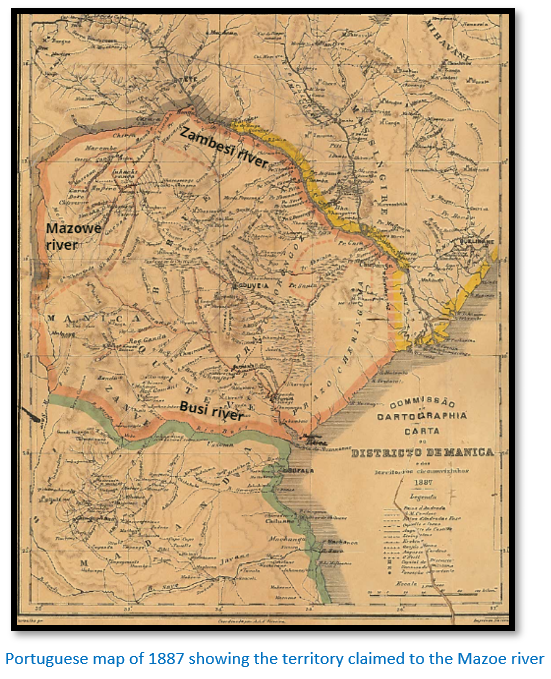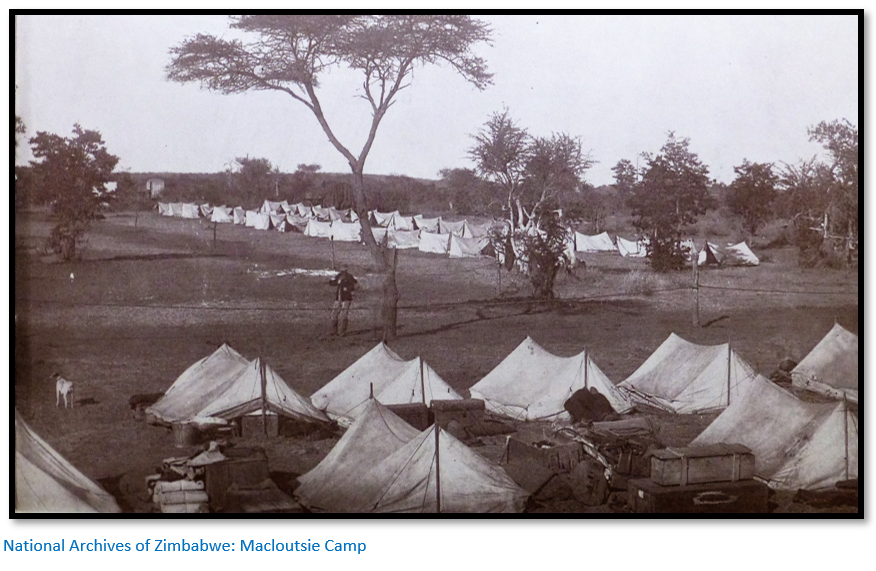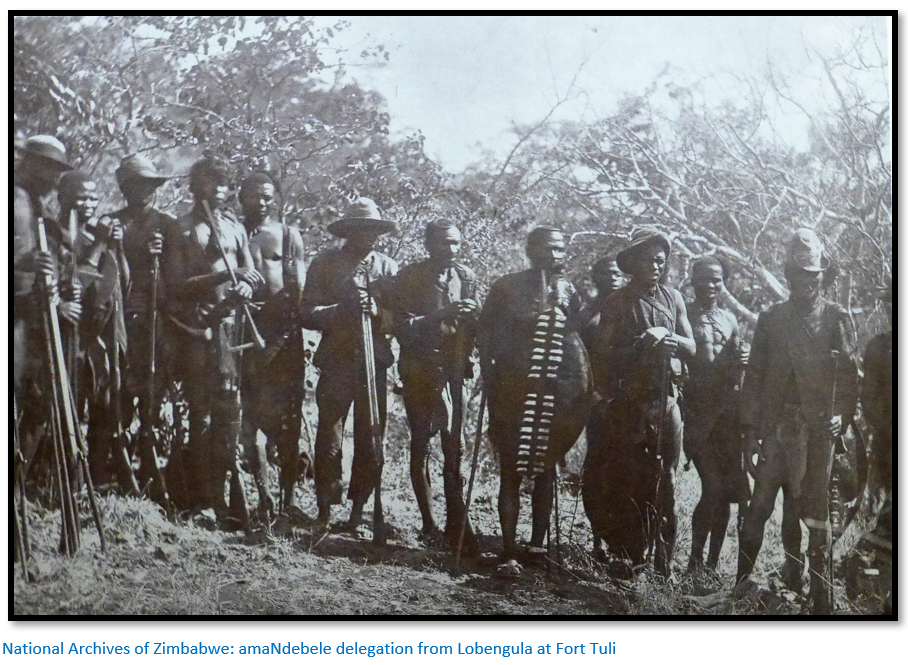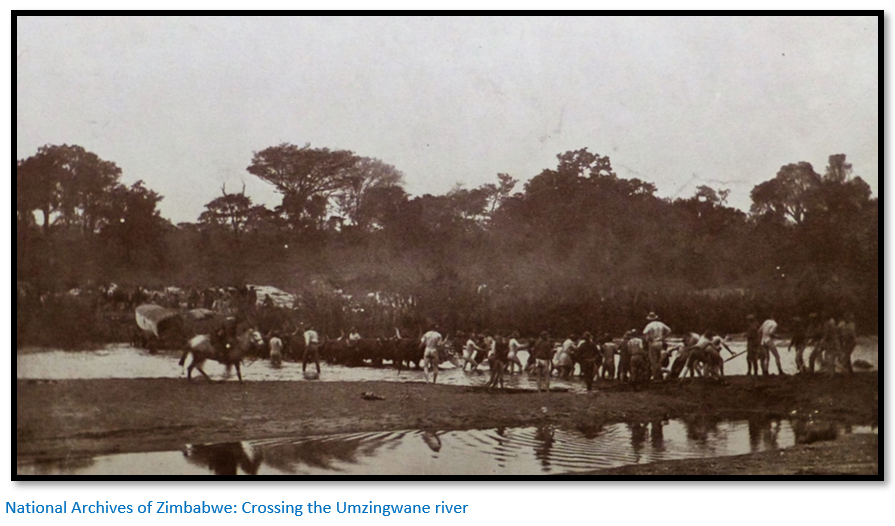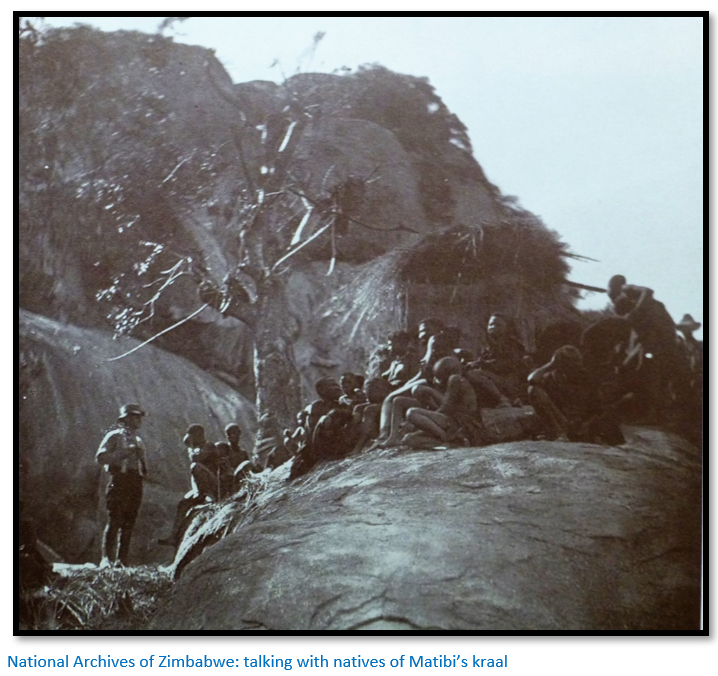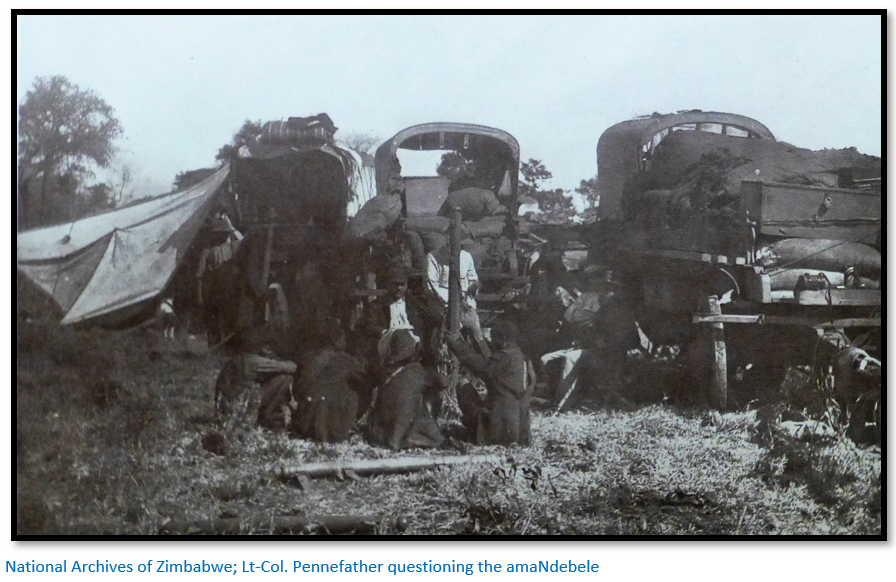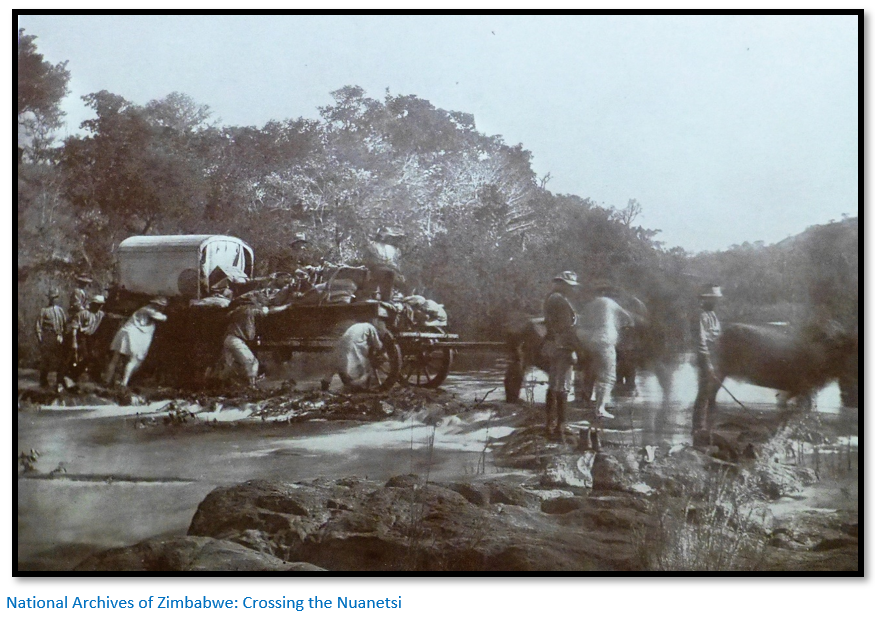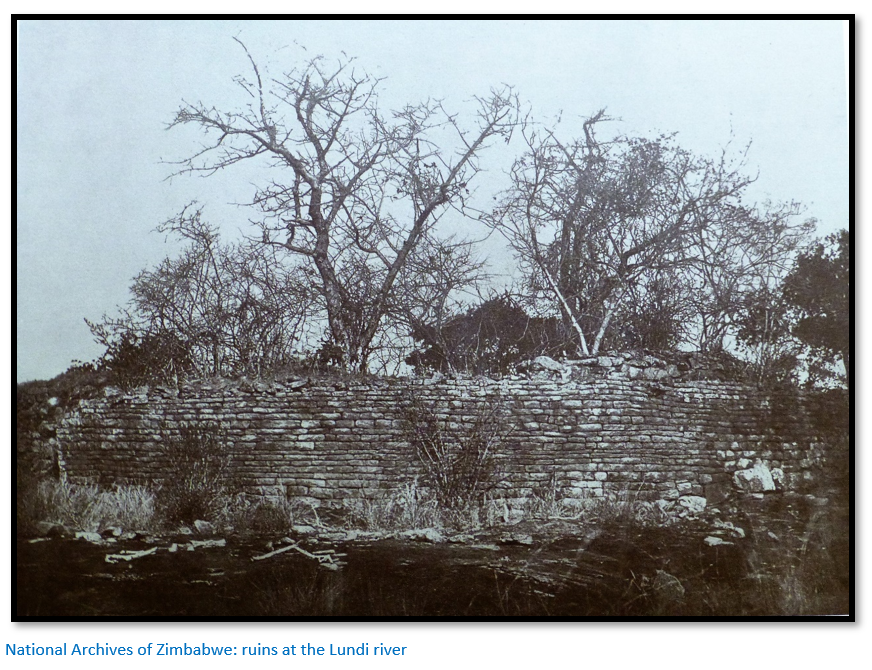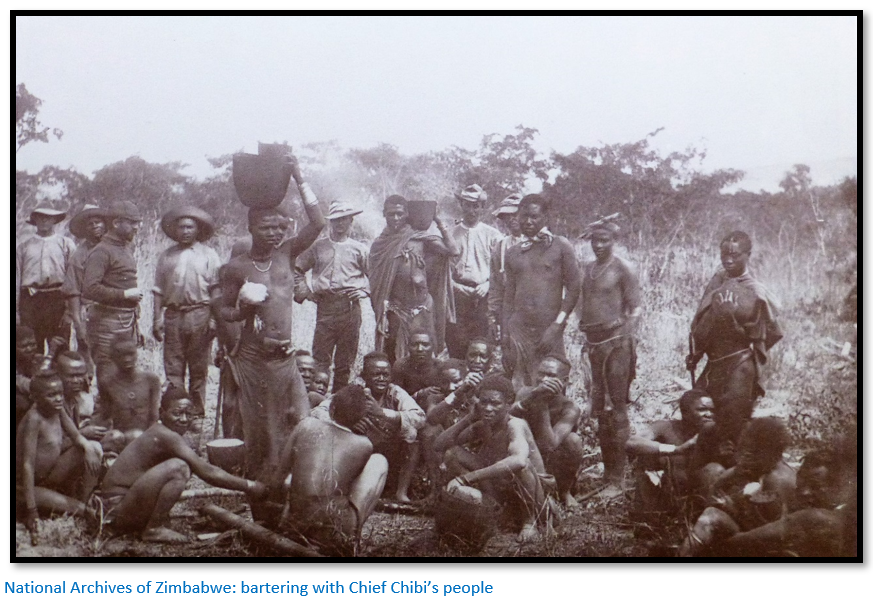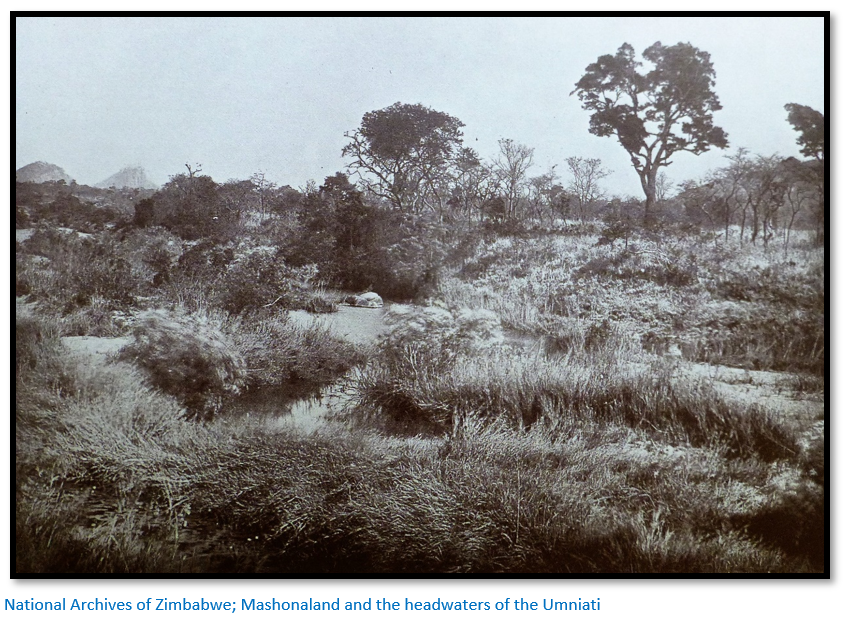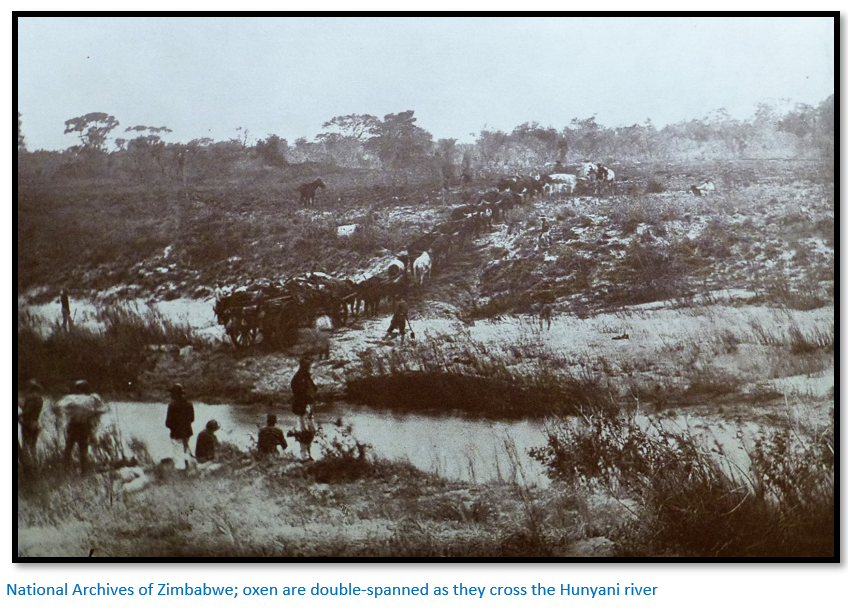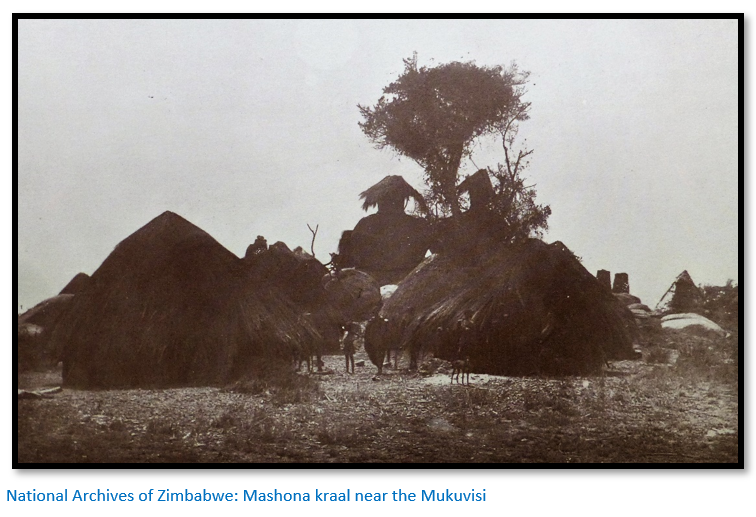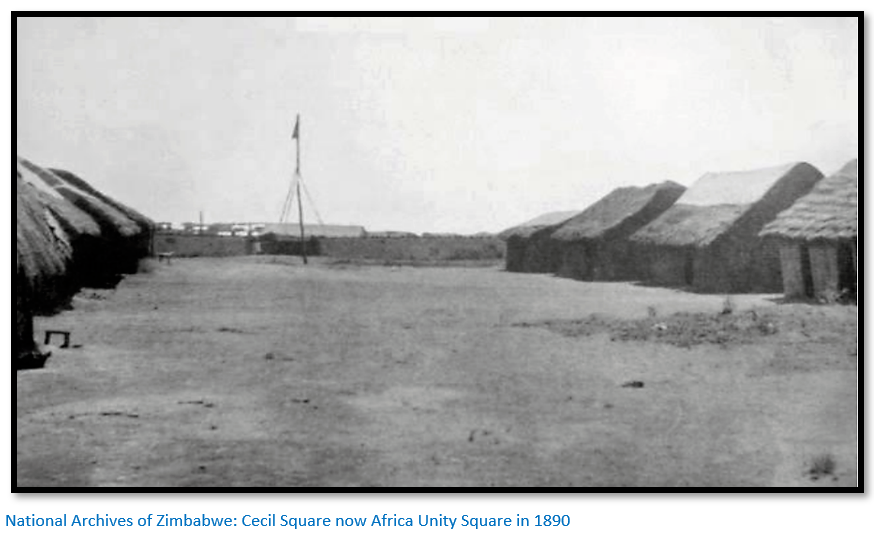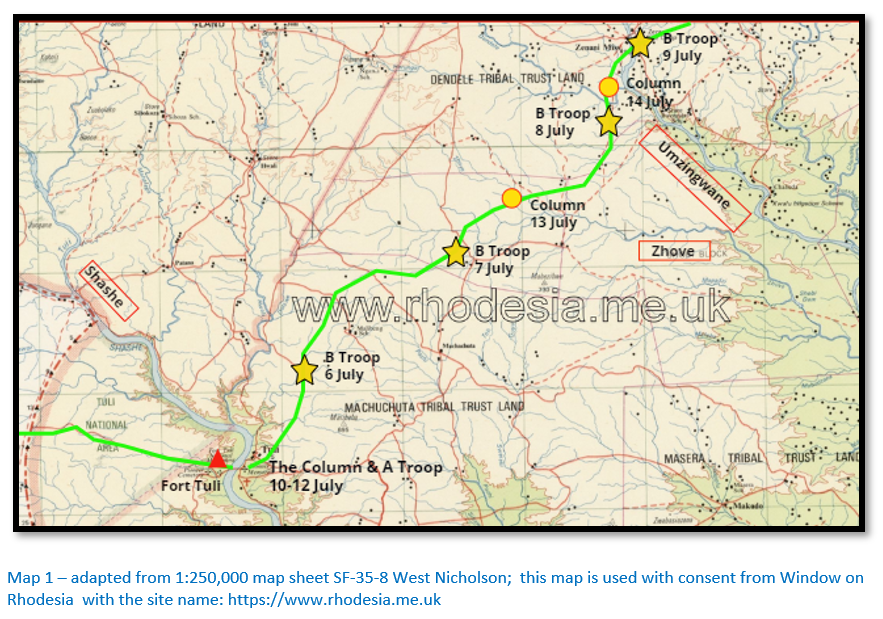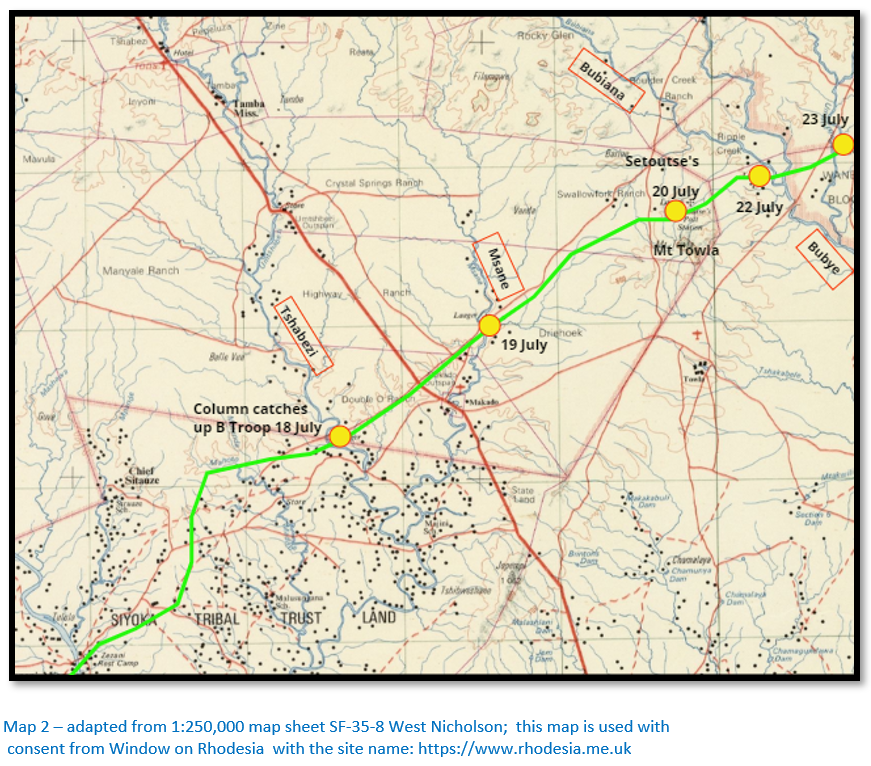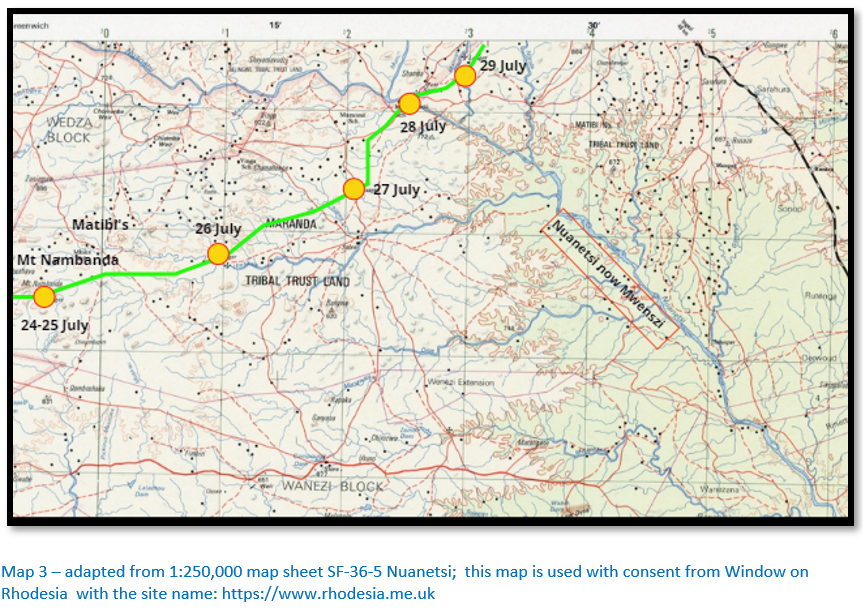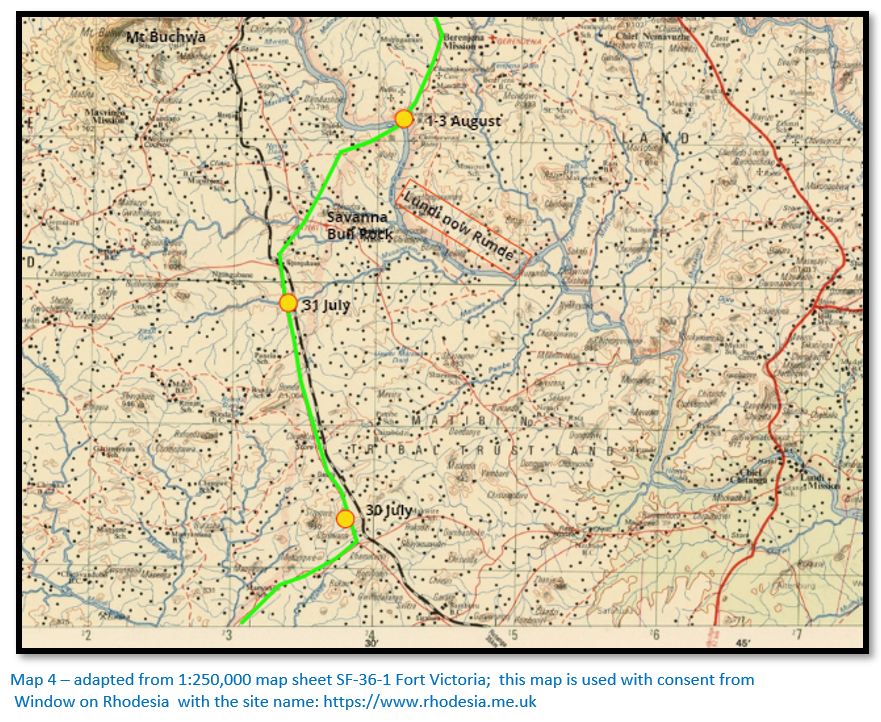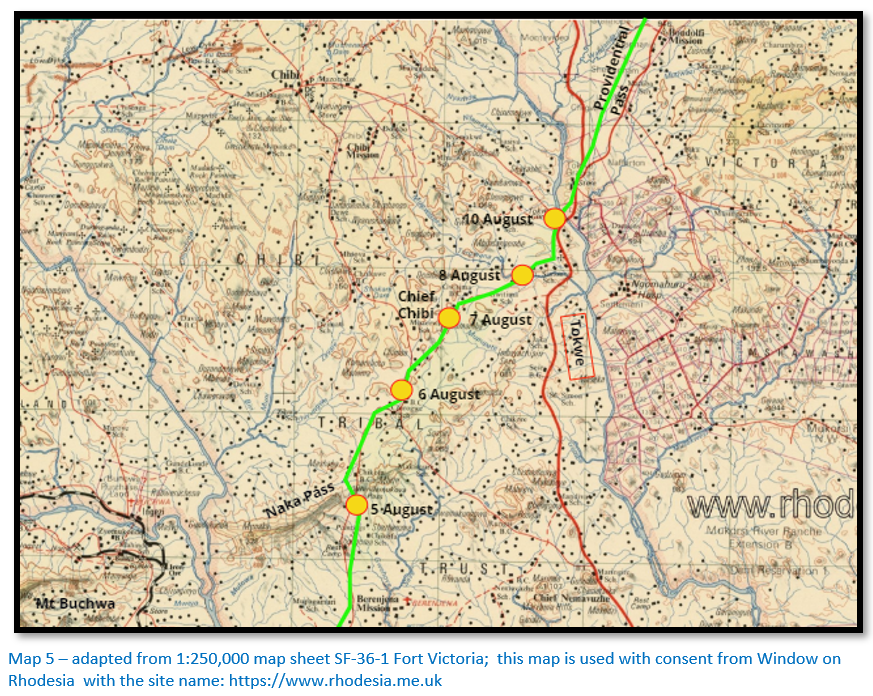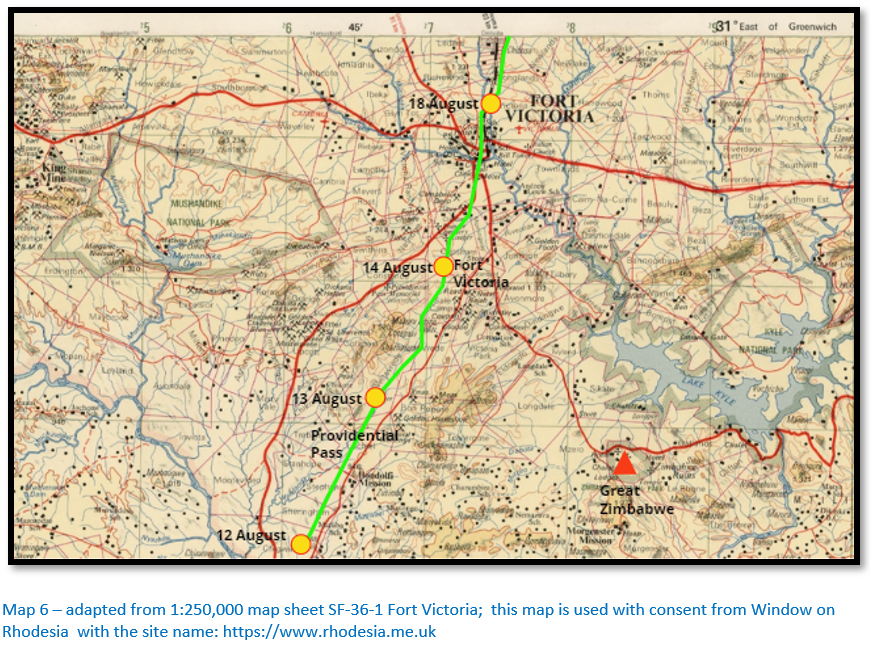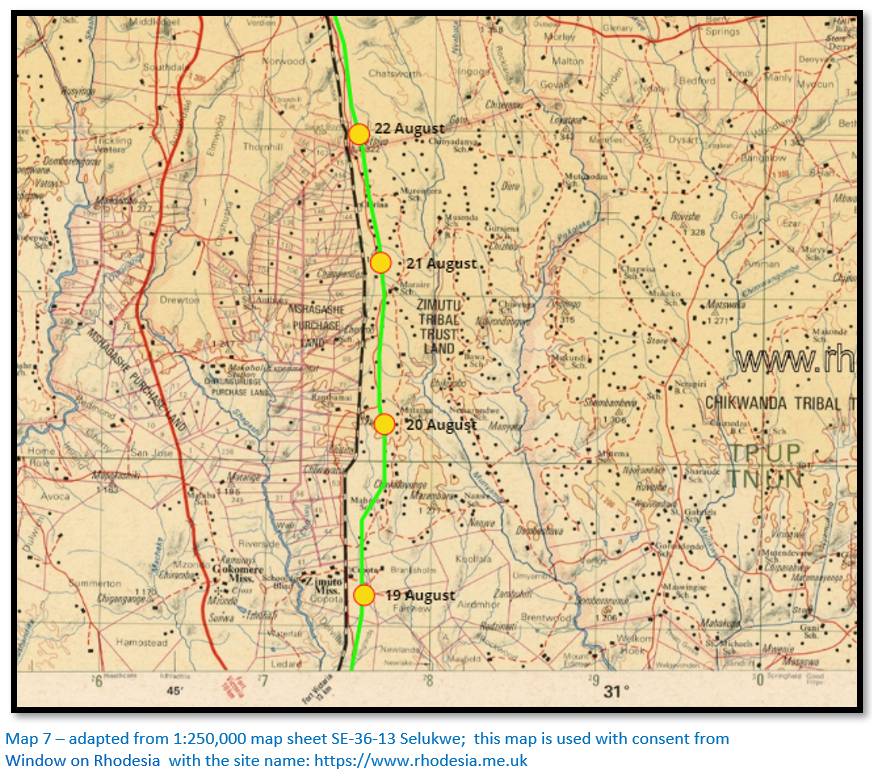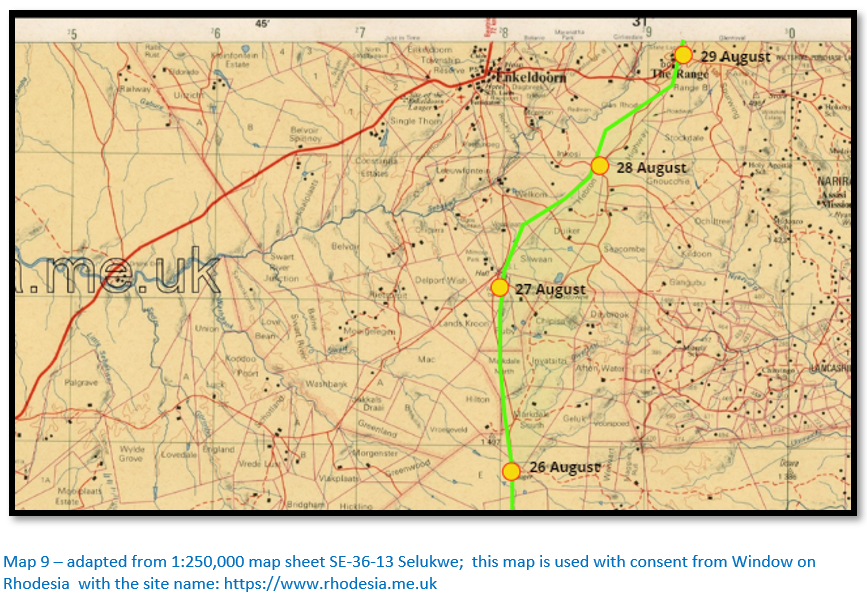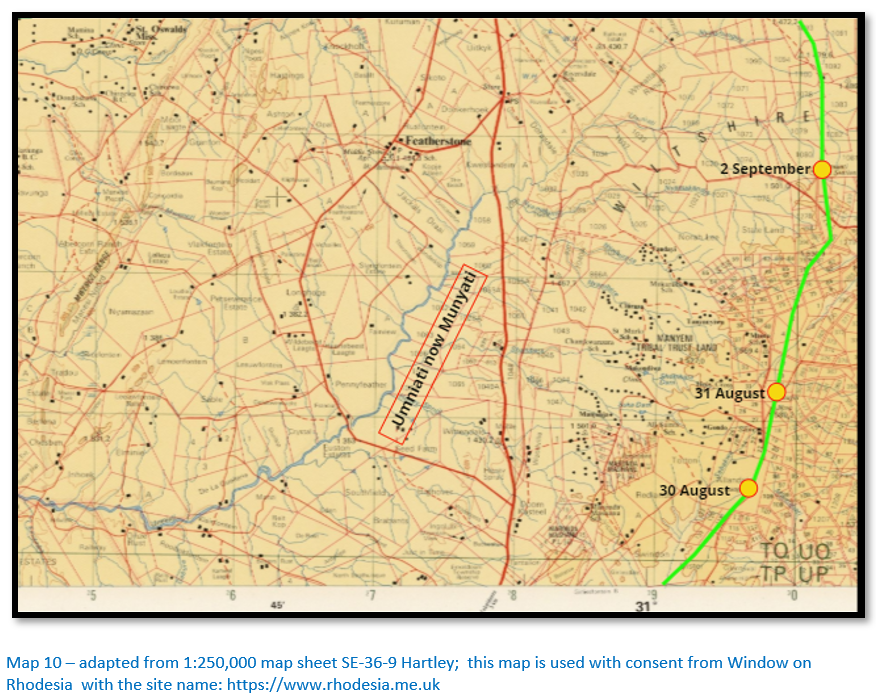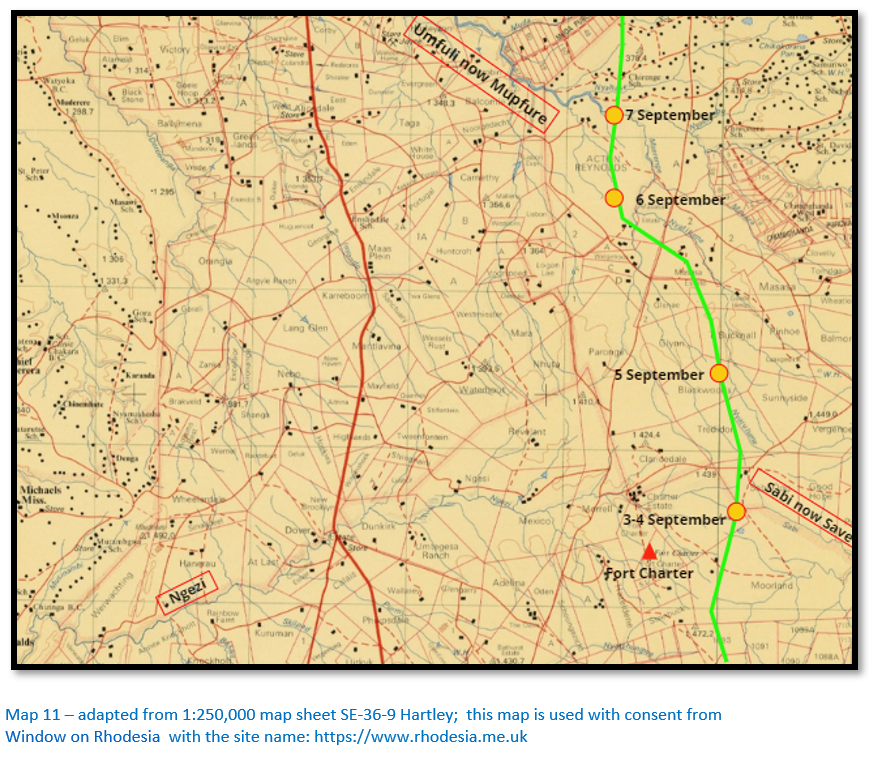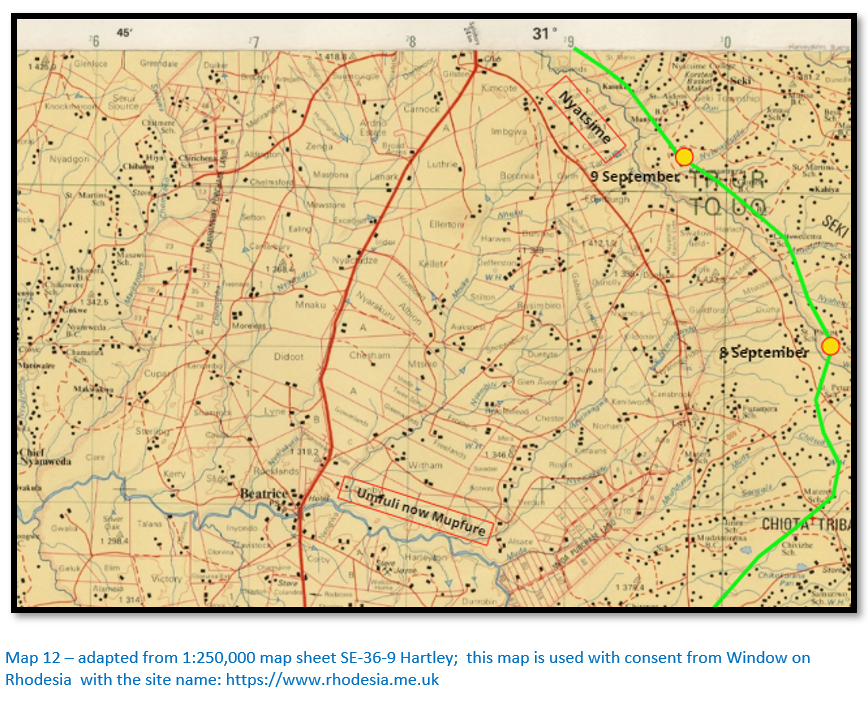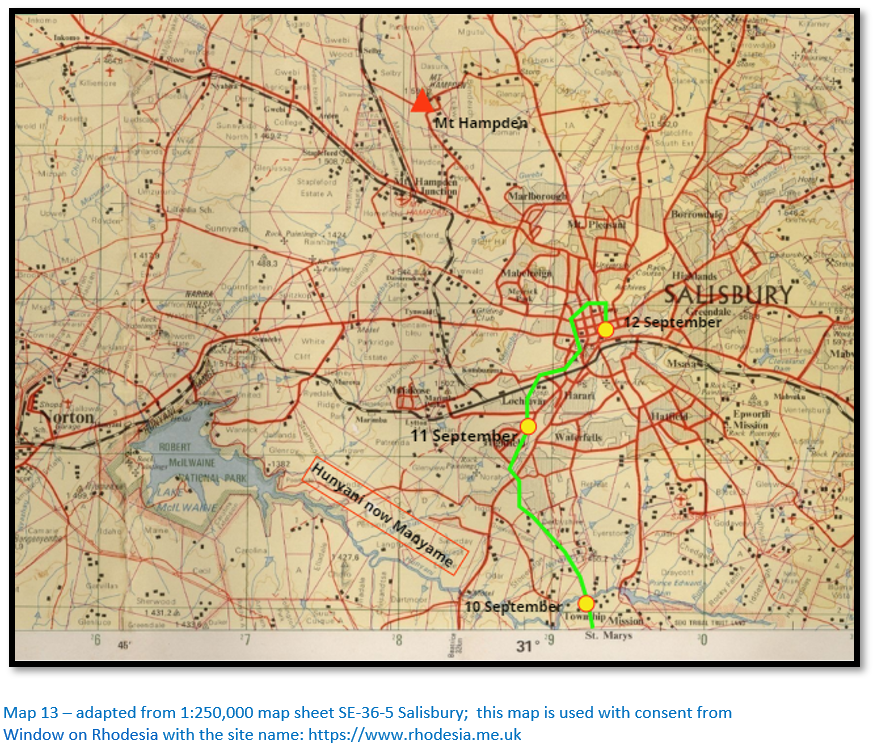The Pioneer Column’s march detailed on maps
Of the men who made up the Pioneer Column Adrian Darter writes: “The Pioneers were men who went out to make history for the Old Country and the lives given are but the milestones of the great British Empire.”[i]
For background to the Pioneer Column and details of the men who actually made up the Pioneer Corps and the British South Africa Company Police (BSACP) refer to the article The Pioneer Column’s march from Macloutsie to Mashonaland under Harare on the website www.zimfieldguide.com Although this has a map of the route they took in order to reach Fort Salisbury, this article will provide greater detail of the actual laager sites and day-to-day detail of the thoughts and impressions of those that actually took part in the journey.
The maps used are from the 1:250,000 map sheets published by the Surveyor General Rhodesia in the 1970’s and used with consent from Window on Rhodesia with the site name: https://www.rhodesia.me.uk and have been adapted for this article.
Background
The occupation of Mashonaland had to been done relatively cheaply as the authorised capital of the British South Africa Company (Chartered Company) was a comparatively small amount of £1,000,000 of which just £300,000 was called up and in addition to providing for the Pioneer Column, the Chartered Company had also to finance the construction of the railway from Kimberley to Vryburg and Mafeking.
It was a very relieved Rhodes who finally learnt that the Cape Government would finance the £500,000 required for the railway and would carry out the construction work.[ii]
Early political manoeuvres in 1889 with the amaNdebele King Lobengula
In 1889 it seemed quite likely that Lobengula would disown the Rudd Concession of 20 October 1888. Many of the disappointed concession-seekers had been quick to point out that the King had rather naively agreed to what he thought was a piece of paper giving the Chartered Company merely permission to dig a hole for gold. [See the article Were Lobengula and the amaNdebele tricked by the Rudd Concession under Bulawayo on the website www.zimfieldguide.com]
Despite everything you may read the ordinary Troopers’ view of Lobengula as expressed by Adrian Darter was: “The feeling of having been spared by a man who had it in his power to destroy produces a sympathy that is human; and a man that can keep his word – no matter what he does otherwise – is a man that deserves admiration of us.”[iii]
In October 1889 Rhodes managed to persuade Dr L.S. Jameson to drive up north to stay with Lobengula and try to bring the King into a more reasonable frame of mind. Jameson was assisted in his efforts by an armed incursion of Portuguese organized by Colonel Paiva d’Andrade of the Mozambique Company, who wished to establish Portuguese claims to Mashonaland by some form of occupation. This annoyed Lobengula and together with veiled hints of the Boer menace from Jameson led him to ratify his previous undertaking that a British party might safely come up to his country to dig for gold and he also accepted the first consignment of rifles which formed part of the Rudd Concession.
In December 1889 a small party of prospectors employed by the Chartered Company arrived at Tati, but their results were disappointing and Jameson asked the King if their efforts could be switched further east producing a map of Selous’ proposed route and asking if the prospectors could use this route. Lobengula agreed and even promised 100 labourers to help make a road. Jameson was delighted and left Matabeleland on 14 February 1890.
Lobengula was also influenced by a second despatch from the Colonial Secretary approving the award of the Rudd Concession “a grant to one group of men to avoid disputes” which was brought up by a three officers and one non-commissioned officer of the Royal Horse Guards in full uniform which much impressed the amaNdebele.
However when it still looked increasingly likely that the King was likely to refuse to acknowledge the Rudd Concession, Rhodes was forced to consider other options.
A plan to assault the amaNdebele Nation
One plan considered was for a flying column of five hundred mounted fighters to carry out a sudden attack on Lobengula and defeat him militarily. Frank Johnson, an unsuccessful concession-seeker was enthusiastic about this proposal and was prepared in November 1889 to draft a plan.
However, Frederick Courtenay Selous had arrived in Kimberley at the same time with the aim of warning Rhodes of the danger of the Portuguese threat to Zambesia if he did not move quickly and decisively. They already claimed Portuguese territory extended as far as the Mazowe river on their maps as seen below.
Selous proposes an alternative plan
When Rhodes told Selous at Kimberley on 6-9 December 1889 of the plan for a military attack on Lobengula he was aghast at the potential danger of invading Matabeleland…surely the answer was to skirt all the territories claimed by Lobengula by building a road to the east that lead into Mashonaland? Selous knew Mashonaland well and his proposal had three major advantages:
- It avoided potentially serious conflict with the amaNdebele
- Many Shona chiefs declared they owed no allegiance to Lobengula and Selous had obtained a concession with Chiefs Mapondera and Temaringa which backed this up
- In Selous’ view, the best goldfields were in Mashonaland and not Matabeleland
Selous wrote to his mother: “The whole idea, too, of making a road at all and thus circumventing the Matabele and gaining possession of Mashonaland was all my own. I proposed it to Rhodes on my return from the Zambezi last December; at first he did not like the idea but after thinking it over resolved to try and carry it out.”[iv]
Rhodes was hesitant but saw the advantages of Selous’ suggestion – it was a less dangerous alternative to an attack on Lobengula. Johnson was furious but was forced to concede that it was a better scheme for the occupation of Mashonaland although he would always harbour a feeling of resentment against Selous.
The contract for the Pioneer Column is concluded on 1 January 1890
The result of these intense discussions was that Johnson, Heany and Borrow agreed to give up their rights in the Selous Exploration Syndicate and Selous accepted £2,000 from Rhodes for his efforts. [A detailed account of the background to the negotiations is included in the article Henry Borrow, after whom Borrowdale is named and is included under Harare on the website www.zimfieldguide.com]
A contract dated 1 January 1890 was signed at Cape Town on 14 January whereby Johnson in partnership with Heany, Borrow and Selous agreed: “…to make or construct a road from Palapye to a point known as Mount Hampden, the road to be so constructed as to leave the towns or kraals of the native chiefs Chilimanzi and Umbigusa to the westward…to have the aforesaid wagon road completed to Mount Hampden on or before 15 July 1890.
…to hold and occupy a certain portion of the territory which is included in the Company’s sphere of operations until the 30 September 1890 at which date the said Company shall be bound to relieve the said contractor of all further responsibilities.”[v]
Johnson’s contract price to the Chartered Company was £87,500 with a land grant of 80,000 acres (32,375 hectares) and 20 gold claims for each of twelve persons nominated by him.
Each member of the Pioneer Corps would receive 15 gold claims and the right to 3,000 acres (1,214 hectares) but since the Chartered Company had received no land rights under the Rudd Concession any member of the Pioneer Column was forced to agree that they: “…would be on terms which I have verbally communicated to you.”[vi] This of course created difficulties which were exposed on the 17 June below.
Johnson wrote in Great Days: “You give me a cheque for £87,500 and supply me with field and machine guns, rifles and ammunition and I will undertake to hand Mashonaland over to you fit for civil government within nine months.”[vii]
Johnson also had: “…to endeavour to the utmost to prevent the entrance into the territory in question of anybody or bodies of armed Europeans or natives or any other hostile armed Force…”[viii]
And he had to raise and equip the Pioneer Corps and: “…to pay all expenses necessary for the raising, maintenance and equipping of such European or Native troops or both, as (he) may deem necessary for the due protection of his road-making parties.”
Lobengula is persuaded by his Councillors to change his mind
Shortly after Jameson left in February 1890 the King claimed to have been tricked and said he had merely given permission for a hole to be dug in the ground in the Tati area which was the subject of dispute between the amaNdebele and the BamaNgwato. His principal inDuna Lotje and his entire family were executed as Lotje had supposedly advised Lobengula to accept the Rudd Concession and E.A. Maund, representing the Exploration Company, a rival concession-seeker was sent with two of Lobengula’s izinDuna to protest to Queen Victoria. [See the article Why Lobengula sent envoys to Queen Victoria in the nineteenth century under Bulawayo on the website www.zimfieldguide.com]
Selous arrives to begin the road to Mashonaland
Selous knew Mashonaland well, but not the Limpopo region and went to gather information on the possible route from an old hunter Klein Jan du Preez in the Zoutpansberg. Then he moved to Palapye: “…There I was to meet Mr Johan Colenbrander from Buluwayo with a hundred of Lobengula’s men with whom I was to go on with the roadmaking towards Mashonaland.”[ix]
When Selous arrived in Palapye in early March 1890 to begin the road, the 100 labourers promised were not assembled and he wrote: “Knowing Lobengula’s shifty, procrastinating ways and having very strong doubts in my mind as to the sincerity of his professions of friendship, or promises of assistance in making the new road, I resolved to ride into Buluwayo and find out myself if he was really prepared to co-operate with the British Company.”[x]
On 17 March he met Lobengula to be told: “There is only one road to Mashonaland and that goes through my country and past Bulawayo.” The King now feared: “that the Boers (would) have easy access to this country by that road and (would) join the Portuguese in Umzila’s country and make a combined attack upon him.”
Both Johnson and Jameson were furious with Selous’ actions and Jameson decided to see the King himself arriving at his capital on 29 April; the same day Heany took charge of Camp Cecil. They negotiated for several days but now there was no room for compromise. At their last meeting on 3 May Jameson said to the King that a force comprising the Pioneer Column was coming into Mashonaland along the road proposed by Selous and if the amaNdebele opposed it there would be fighting between them.
Raising the Pioneer Corps
Nine months from 1 January to 30 September 1890 was very limited time for all that needed accomplishing and Johnson was quickly organising:
- Recruiting agencies in Cape Town, Port Elizabeth, East London, Queenstown, Kimberley and Johannesburg. Over 2,000 applications were received.
- Traveling in the Western and Eastern Cape Provinces for wagons and horses and leasing Kenilworth farm near Kimberley to billet the horses
- Ordering supplies and equipment from uniforms to horse feed to a searchlight powered by a 16-h.p. steam engine and Maxim guns
- Establishing a base camp ‘Camp Cecil’ with Maurice Heany and drawing up a training program
- Drawing up regulations for the Pioneer Column
- Dealing with queries from Rhodes and Sir Henry Loch’s High Commission staff.
On 18 March the first volunteers were attested in Kimberley by Borrow at the Central Hotel. Each recruit “faithfully declared, undertook, promised and agreed” to serve the Chartered Company for a minimum period of six months on the understanding this could be extended to 15 months at the Company’s option.
Adrian Darter was recruited by Nicholson in Pietersburg whilst working at the Murchison gold fields in the Zoutpansberg, but signed his attestation papers at Mafeking and writes: “Each of us was served with a brown cord tunic, grey cord riding breeches, yellow leather leggings, a brown slouch hat, two grey flannel shirts, two pairs of grey woollen socks, a woollen jersey, a pair of ammunition boots, two brown woollen blankets and a water-proof sheet, a pair of heavy spurs, a suit of slacks, a haversack, a water-bottle, a very serviceable ‘house-wife’ filled with thread, cotton and needles of all sizes, a blue-cloth cavalry overcoat – of excellent quality. We were armed with the Martini-Henry rifle, a six-chambered Webley revolver and a hand-axe – the pioneer’s tool and deadly weapon.
The revolver-case and revolver cartridges were slung on a broad brown leather belt. The leather was strong and of good quality. A bandolier with a hundred rounds of ammunition was slung slantwise across the shoulder…The bandolier excepted the equipment was excellent. As a matter of fact I saw considerable service later in mounted corps, but never were the rations or equipment of the Pioneers equalled.”[xi]
On 11 April 6 Royal Navy bluejackets are released to form the nucleus of the Artillery Troop.
On 18 April 85 volunteers under Hoste and Borrow left Kimberley for Camp Cecil.
The ‘twelve Apostles’
When the Royal Charter was signed in October 1889 Rhodes had no idea how Mashonaland would be administered and recruited twelve young men for this purpose the next month but the problem was how to get them into Mashonaland with an escort.
So he approached Sir Henry Loch and requested that the Bechuanaland Border Police (BBP) raise an additional BBP Troop as an escort for the civilian administrators and this Troop would then be employed by the Chartered Company. The Foreign Office agreed to Rhodes’ proposal and the ‘twelve Apostles’ were attested into the BBP on a temporary basis and caught up with the Pioneer Column on the 13 July.
The ‘twelve Apostles’ plus the one hundred recruits moved in December to Fort Elebi, the BPP training centre in the Bechuanaland Protectorate.
1890 Diary of the Pioneer Column | |
April | |
29 | Maurice Heany takes command at Camp Cecil on the Limpopo (Crocodile) River Robert Cary says: “nobody worked harder to prepare the way for the Pioneer Expedition than Maurice Heany; yet it is doubtful whether even at the time more than a handful of people realised how much of the success was due to his efforts…He was the northern link; while Johnson and Borrow procured men and materials in Cape Town and Kimberley, Heany shuttled between Mafeking, Palapye and the Limpopo River – supervising road building, laying out camps, organising lines of supply, setting up depots.”[xii] |
May |
One of the conditions imposed by Sir Henry Loch was that command of the whole expedition, including the 190 men of the Pioneer Corps under Major Frank Johnson, should be given to an experienced regular soldier and Lieut.-Col. Edward Pennefather was appointed as overall commander, taking up his appointment on 1 March 1890. Frank Johnson, the 23 year old who had won the contract was not happy with this arrangement but had to swallow his pride. [There is an article on Lieutenant-Colonel Edward Graham Pennefather 1850-1928 under Harare on the website www.zimfieldguide.com] In a telegram to Rhodes on 6 May to emphasise his demotion he no longer signed himself as “O.C. Pioneer Corps” but used “Contractor for the construction of the road from Bamangwato to Mt Hampden.”[xiii] Formation of the British South Africa Company Police (BSACP) Rhodes had hoped that the Bechuanaland Border Police (BPP) would protect the Pioneer Corps, but another condition of Sir Henry Loch was that the BSA Company should carry the cost of protecting the Pioneer Corps and hence a separate force, the BSA Company Police (BSACP) was formed. However, they were trained by the BBP and many members of the BBP applied for their discharge and joined the new force. Indeed Johnson, Heany and Borrow were all ex-members of the BBP and many of the military traditions of the BBP were woven into the newly-formed BSA Company Police. In early 1890 whilst the first recruits were in training Sir Henry Loch insisted that the Chartered Company’s police force be increased from the original 250 men and Rhodes asked the London Board of the Chartered Company to double their strength. Whereas Rhodes had envisaged the police force remaining in reserve at Macloutsie, Loch insisted they accompany the Pioneer Corps as a military escort to protect them from any amaNdebele attack. |
1 – 25 | Camp Cecil is prepared and the recruits begin to arrive |
26 | Frank Johnson arrives at Camp Cecil and takes charge of training |
June | |
3 | The final 84 recruits under "Skipper Hoste" arrive at Camp Cecil |
4 – 14 | Intensive training is carried out Johnson knew that Major-General the Hon. Paul Methuen, Adjutant-General of the British Forces in South Africa was due to inspect both the Pioneer Corps and the BSACP from about the 20 June and so a period of intense drilling took place. John Edmonds wrote in his diary on 15 June that the men were being: “unnecessarily worried about and overworked, what with parades, drills, fatigues, etc.”[xiv] Others complained there were too many NCO’s; “1 to every 3 men” and others felt that Johnson showed: “a great want of consideration for his men.” Darter who was in ‘A’ Troop writes: “There was plenty of work for we were being drilled morning, noon and night as Major Johnson was determined to have an efficient body of men and night-alarms seemed to be a mania with him.”[xv] |
15 | Recruits march to Macloutsie where the British South Africa Company Police (BSACP) are camped nearby at Fort Matlaputla Darter writes: “We drove our horses day by day on the track northwards, came to a Mopane forest and in a glade we struck – so it seemed – the home of the Lilliputians for the tents in soldierly array were the sweetest little midgets imaginable. This was Macloutsie and the baby tent was a wise method of dispensing with weight and yet giving shelter. They were three feet high and had sufficient room for two to sleep in…the camp was formed in a square. The stores were the first thing that you observed coming from the road. Piles of Boer-meal, sacks, flour-bags and boxes of biscuits and ammunition…Behind the stores was ‘C’ Troop – the Artillery – their tents, guns and horse lines. ‘A’ Troop formed the left of the square with their tents and horse lines. ‘B’ Troop the right and below, nearest the river, the officer’s quarters formed the line opposite to the artillery and stores. The transport department occupied a camp to the rear of ‘B’ Troop lines.”[xvi] |
17 | Five recruits who have requested to be released are discharged Regimental Orders for the 17th stated: “The following men have applied for their discharges at the time when, in the absence of other reasons, it can only be presumed that the prospect of near hostilities has induced them to desire to leave the Corps are struck from the strength of the Regiment…as being unfit for further service in the Pioneer Corps.” Another recruit wrote: “They say that none of the promises made by Johnson were kept and therefore they do not believe us ever getting the farms.” John Edmonds agreed this was the explanation and wrote: “much indignation was shown…as the men had just cause for leaving.”[xvii] |
23 - 24 | Major-General the Hon. Paul Methuen, Adjutant-General of the British Forces in South Africa inspects the Pioneer Corps. Thirty wagons are driven into the countryside and form a laager with an imaginary amaNdebele attack. Permission is given to proceed. Darter writes: “…We had days of manoeuvring and volley-firing and independent firing at targets that had been placed in the bush. We did not know where these targets were but came on them as you might an ambush and received the order to dismount and open fire, either volley-firing or independent firing. We rode to the support of one another and we retired fighting a rear-guard action. Most of the targets were riddled to fragments. Lord Methuen complimented us that night when we were drawn up to receive his words of commendation and he particularly commented on the excellent shooting.” [xviii] |
27 | A Troop leaves Macloutsie for Tuli through the 'Disputed Territory' an area of argument between Khama III and Lobengula between the Macloutsie and Shashe rivers. |
July | |
1
| The Troops begin to arrive at the Shashe river and start building Fort Tuli ‘Skipper’ Hoste writes: “We had hardly finished drawing up our laager when eighteen Matabele warriors resplendent in ostrich plumes and golden-crested crane feathers crossed the river and came swaggering into our camp as if they owned it. They looked awful scoundrels, big, hefty chaps, variously armed with stabbing assegais and guns of various patterns. They all carried ox-hide shields which are the hallmark of a soldier. Borrow took the opportunity of airing his Sindebele on them and chaffed them which amused them greatly and they all roared with laughter at his jokes. The next day as our Matabele friends were still loafing around the camp and were becoming a bit of a nuisance we gave them an ox and told them to go home and eat it. They took the ox, driving it across the river in front of them and vanished from our sight into the bush.”[xix] Hoste writes: “The next day a crowd of thirty Matabele turned up with a letter from Lobengula. ‘Has the King killed any white men that an impi is collecting on his border?’ it asked. ‘Have the white men lost anything that they are looking for?’ As the induna in charge of the party stated his intention of remaining in our camp until the answer was handed to him, the letter was forwarded to headquarters.” |
4 | 250 BamaNgwato labourers and 50 mounted soldiers arrive from Khama III under the command of Rhadicladi. A football match is played in the dry bed of the Shashe river. Pennefather was still writing to Johnson saying matters were behind schedule: “You have not carried out the essential part of my plan for the foundation of the camp, namely that the laager should afford flank defence for the eastern and south-eastern faces of the kopje.”[xx] “When the thirty Matabele saw this crowd march in they cleared out at their best speed and crossed the river.”[xxi] “That afternoon “B” Troop being full of beans at the prospect of being first in the new country, challenged the world to a football match. In practice the ‘world’ was the rest of the Pioneer Corps and “A” troop of the police. The field was marked out in the dry, sandy bed of the river. It was awfully hard work floundering around in the deep sand…the result was a draw slightly in favour of “B” Troop.”[xxii] |
5
7
8
| "B" Troop of the Pioneer Corps under Hoste crosses the Shashe with Selous and Jameson to begin building a wagon road “…When we had fallen in and had been inspected by the O.C. we marched off amidst the cheers of the rest of the column who had all turned out to see us off. Carrying the big axes with which we were to chop the road through the bush to Mashonaland we rode across the sandy bed of the Shashe and landed on the other side. We were the first members of the expedition to enter Mashonaland officially.”[xxiii] That night they slept about 8kms (5 miles) on: “we formed a zareba of thorn bushes for protection in case of sudden attack. At one end we placed our wagon and at the other the water cart. The area in-between we enclosed with a thick hedge made from branches of thorn trees. We stretched a picket rope between the two wagons and every man who was off-duty slept behind his own horse. We posted three men outside the zareba and three more inside with a non-commissioned officer in charge of the lot. Jameson, Selous, Dr Lichfield, Beal who was my subaltern and I slept at the wagon also close to our horses.” B Troop continues cutting the road Hoste writes: “The next day the trees began to thin out a little and we cut about 21 kms (13 miles) of road. That night we camped at a Makalanga village where the people were very civil selling us goats, sheep and milk and also supplying us with two guides. They told us the Matabele had not been their way for some time, a fact which their prosperous condition told us far better than anything they could say.” B Troop cross the Zhove[xxiv] river at 9am and get within 5 kms (3 miles) of the Umzingwane river The Umzingwane, now Mzingwane is crossed and a zareba built on the eastern bank The scouts spot three Matabele who are apparently unaware of them. “We stayed on the Umzingwane for a day to rest the men and sharpen the axes, which were getting a bit dull on their diet of mopane trees. We found a species of soft sandstone on the banks of the river that put quite a good edge on them.” Hoste states the river had a sandy bed but in one of the pools of water he rigged a fishing line and soon caught four barbels weighing about 1.8 kgs (4lbs) each. Beal took off some of the men and soon they had caught enough to have a fish dinner! |
10 | The Pioneer Corps and A Troop BSACP cross the Shashe river; C Troop under Sir John Willoughby would follow on with the reserve supplies B Troop meanwhile had to cut their way through thick mopane forest but covered about 24 kms (15 miles) and camped the night about 8 kms (5 miles) from the Tshabezi river |
11 | "D" Troop BSACP garrisons Fort Tuli; "E" Troop BSACP stays at Macloutsie camp At Ipagee stream about 17.5 kms (11 miles) from Tuli Darter writes: “…and the chief actor was Selous for none knew the way but him. He rode ahead on one of his fine hunters and pointed to a tree, a pioneer sprang to it and felled the obstacle. Should it be a forest giant two men tackled it and BamaNgwato boys steered its fall by means of a rope…The moment your tree fell you walked rapidly past your comrades employed ahead of you and took your station behind Selous. He indicated an arboreal victim and you sacrificed it speedily.”[xxv] “A and B Troop of the pioneers cut the way right through from Tuli to Salisbury alternatively day by day. This is A Troop’s day – if you have never swung an axe then you have lost the rhythm and music of its bite. They troop behind Selous in half-sections. Right numbers dismount, strip off all accoutrements, rifle, hand-axe, bandolier and tunic, attach them to the horses, rifle in gun bucket and held by wallet strap in front to steady it. Tunic, bandolier, haversack and water-bottle strapped to the front of the saddle by wallet straps. Hand over your horse to your left number and line up. In shirt-sleeves and riding-breeches, booted and spurred, revolver at your waist, you stood, brawny and brown to receive a large axe distributed to you and you move off to Selous waiting for you. His dexter finger is thrown out. You know your work. Meanwhile the left numbers leading the mounts follow on…”[xxvi] B Troop is still ahead of the main force. Hoste writes: “Our orders were to keep on cutting the road and reconnoitring until either our provisions gave out or we found ourselves in the vicinity of a large force of Matabele. In either case we were to fall back on the main body.” |
12 | The march of the Pioneer Corps and A Troop BSACP begins The force comprised 350 fighting men plus Artillery Troop supported by 47 wagons with the prospectors and civilian officials, plus Khama’s 300 men led by Rhadicladi. B Troop meanwhile continues on ahead: “As soon as there was a sign of light in the sky next morning we were on the road again. Soon the trees began to thin out and we made better speed. Eventually at 8am, parched and completely exhausted we reached the Tshabezi river. At first glance the river did not look very promising. There were no signs of water, nothing but sand. To tired and thirsty road-makers the sight was not very hopeful, but on investigation we found we could get as much water as we wanted by digging for it, as the water was there only about a foot below the surface.” |
13
16
| Rhodes' "Apostles" catch up with the column Hoste states there were actually thirteen “Apostles” rather than twelve and calls them the Administrator’s [i.e. A.R. Colquhoun] bodyguard. He and Maurice Heany (O.C. ‘A’ Troop of the Pioneer Column) divided them amongst their troops and on arrival at Fort Salisbury they became the first civil servants of the Chartered Company. B Troop builds a drift across the Tshabezi river Hoste writes: “I had received word from the column to say that they were on the road and had crossed the Shashe. I was instructed to stop where I was until they caught me up which would probably be in five or six days’ time. On the strength of this I gave Selous a sergeant and ten men together with old Mapiti and his ten BamaNgwato to enable him to patrol the country around us. In the evening Selous’ patrols returned and reported they had not come across any Matabele. They had visited several Banyai kraals and found the local natives in a miserable condition most of them living in holes in the rocks like baboons. They told of how they had been raided some months back by the Matabele who had killed all the old men and women that they could lay their hands on and had taken away all the young men, women and cattle. This the Matabele called collecting taxes.” The drift across the Tshabezi is completed B troop clears a spacious site for a laager on the eastern bank of the river. Hoste writes: “That night a brute of a hyena paid us a visit. He came within a yard or two of the zareba at about 8pm as we were smoking our post-prandial pipes and let out a yell that would have roused the dead. Now there was a yarn floating around that the war-cry of the Imbezu, Lobengula’s crack regiment, was the howl of a hyena so I fancy that some of the crowd thought for a moment we were for it. I’m sure Jameson did, for he said nervously in the silence that succeeded the yell: ‘That’s a good imitation!’ However Selous reassured him. ‘Don’t worry yourself doctor, there’s no human throat in the world that’s capable of making that infernal row.’” I do not know if it was because of the hyena scare or not, but the following morning Jameson left us and rode back along the road to meet the advancing column. In the meantime we finished clearing the site for the laager and had everything ready for them when they arrived.” |
18 | The column catches up with "B" Troop at the Tshabezi river Hoste writes: “At 10am on the 18th the column turned up and brought with it a cloudy sky and cold, drizzling rain. B troop stood by to lend a hand if any of the wagons got stuck crossing the drift, but they all got through without accident. There were now 123 of them and they stretched out for over 6.4 kms (4 miles)” Hoste differs from Darter here but the length of the column probably depended on the current terrain. |
19
20 | "A" Troop of the Pioneer Corps takes over road-building Darter writes: “The wagons moved slowly and were strung out for a distance of 4kms (2.5 miles) which is readily understood when you measure the length of each wagon and its span and allow for stoppages, such as a bullock becoming unyoked causing the whole train to delay until the wagon ahead was on the move again… …at midday we halted the march, off-saddled our horses and grazed them near the convoy, cooked our rations and ate our lunch, smoked and lounged until the command of saddle-up was given. Whilst this was being done the cry of ‘eenspan’ or ‘Li Bopele’ could be heard from the conductors. Selous was in advance again, left numbers were his axe-men and right numbers followed with the horses.”[xxvii] The combined force moves on Hoste states the advance party of the column came first followed by the road-makers, behind came a Maxim gun on its galloping carriage followed by the seven-pounder guns. Then came the long train of wagons carrying the equipment and stores and at the tail of the convoy was the rear-guard with another maxim gun. “We all found the rear-guard duties extremely tedious. The wagons moved very slowly at the best of times, but when one of them stuck in the mud the whole procession would have to stop. As the rear-guard had to stay about 400 yards behind, the consequence was that they spent the greater part of their time dismounted and sitting on the ground waiting for the wagons to move on. Much more exciting were the duties of the flanking patrols who rode through the bush on either side of the convoy searching for Matabele spies.”[xxviii] Hoste tells an amusing story about B Troop’s Sgt-Major Browne who sat on a thorn, the part becoming inflamed with horse-riding. He asked the medical orderly who suggested carbolic oil to relieve the pain, but mistakenly administered carbolic acid: “He did not rub for long. In less than a minute he was careering around the laager, holding his breeches up with one hand and shouting and blaspheming as only a Sgt-Major can. I turned out B Troop to catch him which, after a while, we succeeded in doing…The poor chap was very badly burned and had to stay in the hospital wagon for some weeks.” |
22
23
24
25
26
| Laager formed on the west side of the Bubiana river Darter again: “Between 4 – 5pm Selous would be looking out for a likely spot to laager, two ways would be cut to facilitate the incoming wagons going alternately right and left. This was a busy time for it needed the clearing of trees. The leading wagons were sent ahead to form the north side of the laager, the front wheel of the incoming wagon was brought to a standstill just past the hind wheel of the one in front. Once the north side was formed the laagering proceeded rapidly for, as stated, they were moving in two columns. The two sides completed in the same manner, front wheel just past the hind of the wagon in front, the rear wagons forming the south side of the laager. By this method the disselboom’s and trek gear of the wagons were outside the laager. The cattle after having been well grazed were tied to the gear. These successive teams of bullocks as they settled for the night were an effective means of breaking a Matabele rush. The horses were picketed inside the laager. The men slept under the wagons. Frequently at night a false alarm would be given, when the men would man the wagons, four to a wagon, rapidly making a barrier of the wagon loads, Boer meal, biscuits, tinned meat, or ammunition and await the Matabele or the dismiss and then gladly and quietly make for their blankets.”[xxix] Hoste writes: “When we arrived at the Bubye river we had to laager on the south bank whilst a drift was being made. As I was down in the bed of the river with my troop making the drift Biscoe came down to have a yarn. [E.C. Tyndale-Biscoe] He was squatting down there on the bank sucking a piece of grass and chatting. Suddenly he stopped in the middle of a sentence. I looked up to see what the matter was and saw that he was staring fixedly at the north bank of the river. ‘D’you see what I see?’ he asked. I turned and followed the direction of his gaze. I was just in time to see a black face disappear into the reeds. ‘Come on’ I shouted and together we rushed up the slope where we found nine Matabele warriors hidden in the bush. Neither Biscoe or I could speak their language and they couldn’t speak ours but there was no mistaking our meaning when I told them that they had better come up to the laager and speak to the Inkos Inkulu. One of them who was apparently the headman of the party told Colonel Pennefather that Lobengula had told them to see that the Banyai did not hurt us. The Colonel replied that it was very kind of Lobengula to consider our interests in this way and told them to go back to the King and thank him for his care of us. He then ordered that a goat should be given to them and as soon as they got it they went off rejoicing.” The drift at the Bubiana Hoste again: “We had a capsize. The wagon for carrying the engine for driving the electric searchlight hit against the stump of a tree in going down a steep bank and turned right over. At the time my troop was acting as rear-guard and Major Johnson rode back in a great state of agitation. He told me what had happened and told me to scare up all the old sailors that I could find to put the wagon back on its wheels again. I accordingly left Beal in charge of the troop and taking my brother Derick and a man named Baker, both of whom had served at sea, I went to C troop and borrowed the crews of the machineguns who were all sailors. We arrived to find the wagon lying on its back with its wheels uppermost. The engine, lashed inside, was completely hidden. Fortunately there were plenty of large straight trees in the vicinity, so we turned to and cut down three of them which we rigged up as sheer legs. For five hours we sweated and strained at the job and eventually we got the wagon back on its wheels again. A quick inspection revealed the only damage was a slight crack in the smoke-stack which had been unshipped and lashed alongside the boiler.” A shot alarms the column Hoste writes: “The bush in this part of the world was extremely thick and if the Matabele had wanted to ambush us this would have been an ideal place. With only a narrow road cleared through the trees we had no hope of forming a laager.” In the morning when B Troop were acting as flankers, a shot rang out. The column halted immediately and in the commotion, expecting an ambush, Hoste rode across to the left flank to see what the trouble was. Trooper Harvey had suddenly come across a herd of zebra and he had fired a shot. Harvey was placed under immediate arrest and the column continued with Harvey being severely reprimanded in the Orderly Room next day. The column arrives at Matibi’s kraal The column laagered for the day in a natural amphitheatre surrounded by high rocky kopjes, the valley floor covered in stunted leafless trees with huge baobab trees in the middle distance. Hoste wrote: “Stuck up in the most inaccessible places and disguised to look like the rocks in which they were scattered were the huts of the Banyai. When they saw we had not come to harm them they came down in crowds to trade mealies, pumpkins, beans and nuts. They told us that so far as they knew there were no large bodies of Matabele about, but some months before our arrival they had been raided, many of their men being killed and a lot of women and cattle carried off.” The laager broke up in the afternoon and the column crossed the Umtshungwe river[xxx] which took five hours as the bottom of the river was muddy and many of the wagons got stuck. “However all hands to, most of them stripped to the bare buff and with much shoving and shouting the wagons were eventually got through. The men both pioneers and police were all young and full of high spirits. They looked upon a troublesome crossing as a spree and enjoyed themselves hugely, shouting at the oxen, pushing at the wagons and whenever they got the chance, ducking one another.” A Sunday with only half a day’s trekking The laager only broke up at 12:30pm. Hoste says the afternoon’s march was through the loveliest country he could remember having seen as they followed a winding valley between high granite mountains on which they could see groups of Banyai watching them pass. A group of sixteen amaNdebele came across A Troop cutting the road and told them to quit work and go home. Nobody paid them any attention and they wandered off into the bush. Another group of twenty amaNdebele turned up with questions: “What has the white man lost? Why are they looking for it in our country?” before leaving. The same afternoon a large grass fire came racing down – probably deliberately started – and the Troops were left covered in ash but unable to wash until they reached water. |
27
30 | The Nuanetsi now Mwenezi river is reached and a drift made Although the river was only 90 cms (3 feet) deep, it ran swiftly between high banks. Hoste says the drift was not well made and many of the wagons stuck badly. “While some of the men took the strain on ropes attached to the trek chains of the oxen, others in the river heaved and pushed at the wheels coaxing the wagons over the more difficult places. It was hard work splashing about waist-deep in the swirling water, but in the end we got everything across without accident.” In the evening just after laagering a scout rode in to report the sighting of a large group of amaNdebele about 8 kms (5 miles) away. Everything was made ready for an attack. More trees than usual were cut down around the laager and dynamite mines laid in readiness, the searchlight played around the surrounding bush all night and nobody slept much. |
August | |
1 | Lundi now Runde river is reached In the morning it was found that the electric cables running out to the mines had been nibbled away by spring hares and the patrols sent out reported no sign of the amaNdebele. That evening found them laagered under Savana Buli rock which rose in a great granite mass 150 metres (500 feet) looking like a giant thumb sticking out from the ground. Selous had been away a few days reconnoitring a route onto the highveld and came back in great spirits having found a good route which he had named Providential Pass. He was in the orderly room tent telling Hoste about his discovery when: “suddenly we were startled by a most infernal din; yells, shouts and screams accompanied by the yelping of dogs. ‘By gad, they’ve caught us on the hop’ Selous exclaimed jumping to his feet. We rushed out of the tent, revolvers in hand, fully expecting to find a Matabele impi on the rampage. All we saw was an unhappy hare being chased through the camp by a mob of wagon drivers and a mixed pack of dogs.” In the afternoon they reached the Lundi now Runde river which was wide and about 1.5 metres (5 feet) deep and flowing swiftly between steep banks. |
2 | Drift over the Runde river formed The whole day was spent preparing a drift. There was a very rocky bed which was raised with sandbags and took the whole day to prepare. |
3 | The column crosses the Runde river The first wagon entered the water at 8 am. “All hands with the exception of outposts were on the job, most of them stripped to the bare buff. The shouting, splashing, cracking of whips, intermingled with yells of laughter and assorted farmyard noises was simply deafening during the four hours we were crossing. Pausing for breath after helping to ease the wheel of a covered wagon over an underwater obstacle, Borrow noticed the doctors and chaplains sitting comfortably inside. ‘D’you realise there are dry men in this wagon?’ he asked the man next to him. ‘We’ll soon see about that.’ Without more ado the naked men in the river assailed the wagon and dragged the protesting men into the icy water. Hosking, the hospital orderly, resisted fiercely, but finally overcome by numbers he was ducked swearing eternal vengeance on his tormentors.”[xxxi] The last wagon was across and the laager on the northern bank completed by noon. Johnson shot a fine bull hippo a couple of miles above the drift. ‘Rocky Mountain’ Thompson immortalised as Bill in Jock of the Bushveld told Biscoe and Hoste where they could find some native ruins about two miles away. “As we were both off-duty that afternoon we rode off to look for them. We found them without much difficulty. They were small and of course covered with creepers but in a wonderfully good state of preservation…We hunted through the debris and found some iron ore and slag.”[xxxii] |
4
| Rest day This: “was a boon for which men, horses and oxen were very grateful.” |
5 | "B" Troop resumes road-building The sandbags were left in the river for the next wagons that should come along, but were soon lifted, the sand shaken out and donned as garments! B Troop was now road-making and there were far fewer trees to chop down. The local Banyai: “seemed delighted at our coming and flocked into camp every day to sell us corn and pumpkins.” |
6 | Johan Colenbrander arrives with a message from Lobengula Next day they pushed on ahead of the column road-making but at noon a despatch rider turned up from Johnson saying we should halt until the column caught us up. The column came up and laagered in the place B Troop had cleared for them and Hoste went to see Johnson to find out what the trouble was. Johann Colenbrander had arrived with a message from Lobengula to say that he would do his best but he feared it would be impossible to hold his warriors back if we persisted in going on. Colenbrander thought that if the column continued on we would be attacked and wiped out to a man. After some discussion Colenbrander was given a message for Lobengula saying his efforts to hold back his impi’s were appreciated, but if his young men attacked it would be very bad for them. Colenbrander then left for Bulawayo saying the column was doomed to destruction. It was thought that for safety the road-making troop should now sleep in the laager each night. |
7 | Chief Chibi's kraal reached A small party of amaNdebele were spotted in the morning and then a larger party of several hundred were seen in the afternoon as the column neared Chief Chibi’s. |
8 | Tokwane river crossed |
9 | "B" Troop builds the wagon road to the Tokwe river After a hard day of cutting trees the Tokwe river was reached about midday. They found a good spot for a drift but some boulders were in the way and as they had drills, hammers and dynamite in the scotch cart five of them spent the afternoon in the river, stark naked except for hats, drilling holes for the dynamite charges. Hoste says Pennefather rode up to ask how they were getting on and looked slightly shocked at his sketchy costume but made no remark. |
10
12 | The column crosses the Tokwe river Next day after breakfast the wagons started crossing the Tokwe. Hoste noticed a submerged rock that he thought a wagon might get snagged on and asked Sgt Finucane to put a man on it to act as a beacon. Then he noticed the man posted on the rock was Trooper Jameson, Dr Jameson’s elder brother and the oldest man in the Troop. He was pale and rheumaticky and Hoste decided that standing in the river would do him no good. Another trooper came to relieve him but ‘Alabaster Bob’ as he was known objected: “Come off that rock, you silly fool” I called out to him: “you’ll be laid up with rheumatism if you stay there any longer.” “Oh no, sir” he replied: “I shan’t get rheumatism, but I’m suffering terribly from corns and this is softening them up splendidly.” However, in spite of his corns I shifted him. Laager at the foot of Providential Pass The 11 kms (7 mile) route up the pass was through thick bush and gave the amaNdebele an excellent opportunity for a surprise attack as the column laboriously climbed the 300 metres (1,000 feet) The laager was beside a small stream whose banks were covered in maidenhair fern and was accordingly christened Fern Spruit. That evening Father Hartmann went for a stroll and became lost with several search parties sent out to find him without success although he walked in next morning unharmed. B Troop began cutting a road for the wagons as the sun rose and the bush was very thick and tangled. They had barely cut 400 metres when the cracking of the whips told them the column was on the move. This spurred them on and they just managed to keep ahead of the column. About 11am Colonel Pennefather rode up and asked when they had breakfast. When Hoste told him they were unlikely to get breakfast with the column at their heels the Colonel rode back and halted the column and so B Troop managed to get some food. It was hard work hacking a road through the undergrowth and about 3pm a note was received from the Colonel to make a halt at the first suitable spot and clear a space for a laager. They cleared a space and Hoste marked out a spot for drinking water telling his men if they wished to bathe they should use the pool below. “However some busybody told the Colonel they were bathing in the drinking water pool. Then the band began to play!” |
14
15
| The top of Providential Pass is reached Cutting the road began at dawn again and at 8am they emerged from the jungle of the pass into the open plain of the highveld. Hoste says it was a great relief to leave the hot and humid lowveld and the ever-present threat of an amaNdebele attack. The countryside on the highveld is more open and the climate cooler. They laagered about a mile from the head of the pass at a site which was selected to be a fort [This first fort fell quickly into disrepair and construction was started on a second fort, a pentagonal earthwork, situated on what is now Clipsham farm. By the end of the year the water supply here proved inadequate and the town moved to its present position, near the confluence of the Mucheke and Shagashe Rivers early in 1892 and was named after Queen Victoria. In 1899 the town became known simply as Victoria; however in 1917 it reverted to its original name of Fort Victoria until 1982, when its name was briefly changed to Nyanda, but within a few months its name was again changed to Masvingo when it was discovered that Nyanda did not translate very well between dialects. [See the article Masvingo formerly Fort Victoria under Masvingo Province on the website www.zimfieldguide.com] Great Zimbabwe is visited Hoste, Forbes, Canon Balfour and Ted Burnett and Ellerton Fry, the photographer ride to the ruins and after some discussion and the gift of a blanket for the headman were led up to the Hill Complex. “After climbing a precipitous path up the side of a kopje we found ourselves in what looked like a citadel in the enclosures of which the natives were living. We could find nothing very interesting up there as they had evidently utilised the old building to the utmost, pulling down the walls wherever it suited them and using the stone for building new and very rough walls in all sorts of places never contemplated by the original architect.” [For Hoste’s full description see the article Great Zimbabwe, a UNESCO World Heritage Cultural Site under Masvingo Province on the website www.zimfieldguide.com] |
16
17 | "A" Troop played "B" and "C" Troops at cricket. "C" Troop under Captain Keith Falconer[xxxiii] is left to garrison Fort Victoria Major Sir John Willoughby and his supply convoy with C Troop of the BSACP which left Fort Tuli 18 days later than the main body reach Fort Victoria. Selous returns from a three day patrol and believes the watershed will make a good road for the column. On the 17 August Khama III's men under Rhadicladi turn back |
19 | The Pioneer column with A and B Troops of the BSACP[xxxiv] resumes the march from Fort Victoria; B Troop taking the lead building two parallel wagon roads 50 yards apart Road making is now easy in open grassland without the thick mopane bush of the lowveld. As a rule they just attach young trees behind the scotch cart and water cart and leave a spoor for the column to follow. However there was still the possibility of an amaNdebele attack and the rule was Troopers kept their boots on at night. When Pennefather spotted one of the Gardener gun crew putting his boots on one morning: “the colonel promptly went off the deep end and there was no end of a rumpus.” When a trooper asked one of the blue-jackets what the fuss was about he replied: “it ain’t nothink, only one of us chaps ‘as taken his butes off and bloody near pizoned the Colonel!” |
20
22
| Night marches begin The routine was for “B” Troop to start road-making directly after breakfast and after approximately 16 kms (10 miles) to find a suitable laager site. The column which was travelling by night would reach them about dawn. The column’s routine is to march from 3am to 6am where they met the road-making party and then rest during the day and trek again from 5:30pm until 9pm. No direct contact with the amaNdebele The column passes a village where only three days earlier a group of sixty amaNdebele have been collecting tribute in sheep and cattle. Jameson wrote to Rhodes on the 21 July from ‘20 miles north of Fort Victoria:’ “All going well though slowly. Police cattle getting done up.” [xxxv] |
23 | Tyndale-Biscoe in charge of the artillery noted in his diary that going through the sand was heavy work for the oxen. The laager that night was adjacent to present-day Chatsworth |
25 | Laager that night is five miles (8 kms) north east of present-day Felixburg Some slow wagons were being left behind to trek by themselves and catch up as best they could. |
26 | Colquhoun, Administrator-Designate of Mashonaland leaves the column with Selous and Jameson and Troopers to negotiate a treaty at Wedza now Hwedza and then known as Mbire |
29 | Colquhoun returns as Jameson has fallen from his horse and broken ribs |
30 | Laagered nine miles (14 kms) north east of Enkeldoorn, present-day Chivhu Hoste states that at the time there was any amount of game present which they hunted for a change of diet from beef |
September | |
2 | Laager established at headwaters of the Umniati river |
3 | Colquhoun sets off again to negotiate a treaty at Wedza This was the coldest day with a hard easterly gale and showers of icy rain. Hoste says they dug trenches and threw the soil out on the weather side. When the main body arrived at dawn, half dead with cold, “B” Troop were quite warm and comfortable in their trenches! |
4 | Charter site reached and construction of a fort begins The original plan had been to build a fort to the north east near Mount Wedza to act as a block on the Portuguese, but the BSACP oxen were in such poor condition that the column stayed on the watershed and rested for the day. Captain Heyman with “A” Troop of the BSACP was left to garrison the site. Fort Charter was abandoned as a Police Post in August 1891 but continued as a post station. [See the article Fort Charter under Midland Province on the website www.zimfieldguide.com] |
5 | “A” Troop takes over road-building and the column treks away from 3:30 pm to 8 pm They follow the tracks of Selous’ six wagons on his 1887 hunting expedition from Mount Hampden to the Ngezi river headwaters that were still visible in the sandy soils at Charter when the column passed. The distance being travelled each day is getting shorter as the oxen tire. |
6 | Laager at the headwaters of the Sabi now Save river Here they met up with Colquhoun and his secretary Harrison who have returned with a treaty. Selous, Adair Campbell and troopers had gone on to Manicaland to negotiate a treaty with Chief Mutasa. This day the column travelled further as it was less sandy; a distance of 16 kms (10 miles) and within 6.5 kms (4 miles) of the Umfuli. |
7 | Laager on the south bank of the Umfuli now Mupfure river The column catches up with “A” troop who have been road-making on the south bank of the Umfuli now Mupfure river and are now making the drift. The oxen were now so weak they had to be helped across the river. The 'Berthon' boat was tried out here on a long pool of the Umfuli river below the drift. As it is Sunday there is time for Biscoe, Hoste and Ivan Fry to sail up and down a pool of the Umfuli to the amazement of a group of Mashona. Ted Burnett, Nicholson and Langerman walked into the laager. Two of their horses had been killed by a lion and the third scared away from their camp near the Manyame river during the night by a lion. Ted Burnett thought he had shot the lion but it had got away. |
8 | Nyatsime river crossed and followed on its east bank in a north-west direction |
9 | Laager formed 8 Miles (13 kms) south of the Hunyani now Manyame river. "E" Troop starts the march from Macloutsie to Fort Tuli Pennefather, Johnson and Borrow find the carcase of the lion Burnett had shot a few nights before. Hoste states the countryside is well-watered and looks very fertile. There is plenty of evidence that it was formerly thickly populated with signs of destroyed kraals and cultivated lands now abandoned. Hoste writes that the amaNdebele: “had swept the country clean and with the exception of an isolated village here and there perched on the top of an almost inaccessible kopje there were no signs of any inhabitants.” Selous says that one large village he visited eighteen months before had 1,500 – 2,000 inhabitants; now there are none. |
10 | Hunyani now Manyame reached and laager formed on the south bank while the drift was prepared with reeds and the banks cut down. The main column reached the Hunyani in the afternoon and laagered on the south bank of what is now St Mary’s. |
11 | The next laager was formed on the south side of the Mukuvisi at 6 mile spruit (where the Makabusi now Mukuvisi crosses the A4 Harare - Masvingo road) The Hunyani was crossed at 5am before breakfast and a laager formed on the north bank until 3pm when the column moved on following the line of the present-day Simon Mazarodzi road and keeping to the higher ground east of the Mukuvisi stream. Ellerton Fry’s photo shows two spans of oxen pulling a wagon over the drift as the oxen are now in a weakened state. “A” Troop had continued on road-making. Early that morning Lt-Col Pennefather commanding the Column, Willoughby and Johnson rode on ahead to the Gwebi river near Mount Hampden which they reached about 10am and finding a lack of water turned back and camped the night on the site of Salisbury, now Harare. Frank Johnson's contract stated that Mount Hampden was the final destination but that was because it was a known landmark. Several more kraals are seen in the kopjes and the men get their first sight of rock art. [See the article Rockart at Glen Norah East and West under Harare on the website www.zimfieldguide.com] |
12 | The column moved on from 6 mile spruit at 5am and crossed the Mukuvisi travelling north up along the route of the present Simon Mazarodzi Road and then turning north through Highfield and Lochinvar before being directed by Ted Burnett and turning north east[xxxvi] and following approximately the railway line towards and around the south end of the kopje. The column then went north on the east side of the kopje up Pioneer Street now Kaguvi Street before turning east along Jameson Avenue now Samora Machel Avenue and then turning south. In the afternoon the troopers unloaded their tents and pitched them for the first time since leaving Macloutsie at the intersection of First Street (now Sam Nujoma) and Gordon Avenue (now George Silundika) Frank Johnson in his book Great Days stated he persuaded Dr Jameson as Rhodes' representative to accept the current site of Harare rather than Mount Hampden as it was more suitable a site for a future town but in reality the decision may have been made by Pennefather. |
13 | At 10am the Union flag was hoisted in Cecil Square now Africa Unity Square Maurice Heany and ‘Skipper’ Hoste had discussed the parade the previous evening. They decided that as Heany was an American citizen he could not raise the Union Jack so he was elected ‘Captain-of-the-day’ and took charge of the camp; Hoste would command the Pioneer Corps. Johnson, Borrow and Burnett had already left to prospect at Hartley Hills. Hoste woke at dawn and suddenly realised they had no flag-pole! So he roused Biscoe and taking an axe they walked to the nearest clump of trees and selected one with the straightest tree trunk. Whilst Hoste was chopping it down “Reveille” sounded and so Biscoe called some blue-jackets from “C” Troop machine gun crew. After trimming their pole it was carried to the middle of the future fort and erected with signal halyards and stays. At 10am all the Troops paraded in front of their flag-pole with “A” and “B” Troops of the Pioneer Corps in the centre, “C” Troop on their right with two seven-pounders and “B” Troop of the BSACP on the left. Pennefather stood with his ADC Shepstone and Willoughby at the foot of the flag-pole, Biscoe with the rolled up Union Jack stood beside them and Canon Balfour gave a short address and prayer. Then the bugles sounded ‘The Royal Salute’ and Biscoe slowly and solemnly raised the flag. When the flag reached the top of the mast the seven-pounders fired a twenty-two gun salute, the bugles played ‘The Royal Salute’ again and the troopers presented arms. Pennefather called out ‘Three cheers for her gracious Majesty Queen Victoria’ and all the troopers shouted three cheers. |
|
|
15 | "E" Troop arrive at Fort Tuli |
16 | "D" Troop leave for Fort Victoria, now Masvingo |
October | |
1 | The Pioneer Corps was officially disbanded with each member being allocated 3,000 acres of land to farm and 15 gold mining claims |
The Pioneer Column route from Fort Tuli northwards to Fort Salisbury on thirteen maps
References
E.E. Burke. Fort Victoria to Fort Salisbury. The Latter Part of the Journey of The Pioneer Column in 1890. Rhodesiana Publication No 28, July 1973
R. Cary. Charter Royal. Howard Timmins, Cape Town 1970
R. Cary. The Pioneer Corps, Galaxie Press, Salisbury 1975
A. Darter. The Pioneers of Mashonaland. Books of Rhodesia, Bulawayo 1977
W. Ellerton Fry. Occupation of Mashonaland. Books of Zimbabwe, Bulawayo, 1982
A.S. Hickman. Men who made Rhodesia. British South Africa Company, Salisbury 1960
H.F. ‘Skipper’ Hoste. (Edited by N.S. Davies) Gold Fever. Pioneer Head, Salisbury 1977
F. Johnson. Great Days. Books of Rhodesia, Bulawayo 1972
F.C. Selous. Travel and Adventure in South East Africa. Books of Rhodesia, Bulawayo 1972
[i] The Pioneers of Mashonaland, P35
[ii] Charter Royal, P77
[iii] The Pioneers of Mashonaland, P30
[iv] Charter Royal, P58
[v] The Pioneer Corps, P25
[vi] Ibid, P25
[vii] Charter Royal, P83
[viii] The Pioneer Corps, P26
[ix] Charter Royal, P70
[x] Travel and Adventure in South East Africa, P357
[xi] The Pioneers of Mashonaland, P23
[xii] Charter Royal, P83
[xiii] Ibid, P85
[xiv] Ibid, P88
[xv] The Pioneers of Mashonaland, P31
[xvi] Ibid, P28-9
[xvii] Ibid, P88
[xviii] The Pioneers of Mashonaland, P39
[xix] Gold Fever, P42
[xxi] Ibid, P42
[xxii] Occupation of Mashonaland
[xxiii] Ibid, P45
[xxiv] Hoste calls it the Sobe river
[xxv] The Pioneers of Mashonaland, P66
[xxvi] Ibid, P68
[xxvii] Ibid, P69
[xxviii] Gold Fever, P50
[xxix] The Pioneers of Mashonaland, P70
[xxx] Hoste calls it the Mtchwani river
[xxxi] Gold Fever, P56
[xxxii] Mt Buchwa mined for its iron-ore deposits is about 17 kms away
[xxxiii] The is no listing for Capt Keith Falconer in Men who made Rhodesia
[xxxiv] The total force is now about 400 Europeans mostly mounted with 90-100 wagons, each wagon pulled by sixteen oxen with a conductor, voorlooper and general servant who applies the brake and collects firewood and water
[xxxv] Fort Victoria to Fort Salisbury, P2
[xxxvi] The choice had now been made to abandon Mt Hampden as the final destination and use the alternative site that is now Harare

